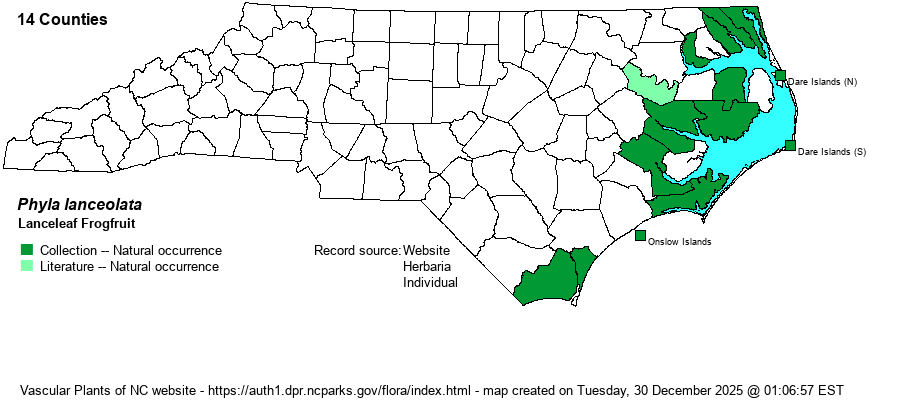| Author | (Michaux) Greene | |
| Distribution | Essentially throughout the lower Coastal Plain and Outer Banks, ranging inland to Chowan, Martin, Beaufort, Craven, and Brunswick counties.
This species has an odd range. It is mainly a Midwestern species, but in the East it is limited mainly to coastal regions. It ranges from PA to SD, and south to central FL and CA. In VA, for example, it ranges far into the Piedmont and mountains, along rivers.
| |
| Abundance | Uncommon to infrequent, and somewhat local, in the coastal regions, usually not far from tidal waters in NC. | |
| Habitat | This is a wetland species, growing in damp ground in swamp openings, along the edges of tidal freshwater to oligohaline marshes, dune swales, pond margins near the coast, and in ditches. | |
| Phenology | Blooms from June to frost, and fruits shortly after flowering. | |
| Identification | This is the more robust of the two Phyla species in the state, and both can grow in similar places in coastal regions. It has an erect to leaning stem, to about 1-1.5 feet tall. The few pairs of opposite leaves are elliptical, about 1.5-2 inches long but only about 2/5-inch wide. The flower clusters are in small, dense heads, on long stalks from leaf axils and the summit of the stem. The tiny white to lavender-white flowers have 5 petals, and they tend to grow in a symmetrical "whorl" when viewed from above. The similar P. nodiflora has shorter leaves that are less than 3 times as long as wide (as opposed to 4 times longer than wide in this species), and these leaves tend to look wedge-shaped (obovate), rounded at the tip. | |
| Taxonomic Comments | Older references had these species in the genus Lippia.
| |
| Other Common Name(s) | Marsh Frogfruit, Northern Frogfruit. Note that the group common name has often been call "Fogfruit" instead of "Frogfruit". It is not clear which is correct, or best to use. | |
| State Rank | S2S3 [S3] | |
| Global Rank | G5 | |
| State Status | | |
| US Status | | |
| USACE-agcp | OBL link |
| USACE-emp | OBL link |

